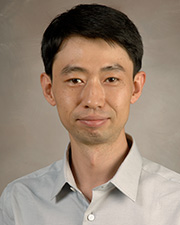Biography
Dr. Bo Hu was trained in Microbiology and obtained his Ph.D. degree from the Nankai University, China in 2010. He came to the University of Texas Health Science Center at Houston (UTHealth) for his postdoctoral training and became interested in high-throughput cryo-electron tomography (cryoET). He has been working on the structure and function of bacterial nanomachines in situ, including phage infection, bacterial flagellar motor and chemoreceptor proteins and bacterial secretion systems. In 2017, he joined the Department of Microbiology and Molecular Genetics at UTHealth Houston’s McGovern Medical School. His research program currently focuses on understanding the structure and function of bacterial secretion systems using cryo-electron tomography.
Education
- Postdoctoral Fellow
- The University of Texas Health Science Center at Houston
- Ph.D.
- Nankai University, China, 2010
Areas of Interest
Research Interests
Structure and function of bacterial nanomachines
- Visualizing structures of nanomachines in situ
- High resolution structures of purified macromolecular complexes.
My researches focus on understanding the structure and function of bacterial nanomachines in situ by using cryo electron tomography (Cryo-ET). For the past years, we have developed a high-throughput pipeline for Cryo-ET data acquisition and processing. This pipeline allows us to automatically and massively collect data and further processing them. This pipeline has been successfully applied to many biological systems/specimens, and has addressed many significant biological questions.
Understanding of the mechanisms underlying bacterial pathogenesis in humans is a major focus of microbiological research and the elucidation of the infectious process yields practical applications of new antibiotics and improved vaccines. One example is the bacterial type III secretion system (T3SS). Many infectious bacteria such as Shigella and Salmonella use type III secretion machines, to transfer virulence proteins into eukaryotic host cells, cause diarrheal disease.
In a very recent study, we report a high-resolution in situ structure of the Salmonella Typhimurium type III secretion machine obtained by high-throughput cryo-electron tomography and sub-tomogram averaging. Through molecular modeling and comparative analysis of machines assembled with protein-tagged components or from different deletion mutants, we determined the molecular architecture of the secretion machine in situ and localized its structural components.
Structural definition of bacterial type IV secretion systems. Type IV secretion systems (T4SSs) are complex nanomachines used by bacteria to deliver protein and DNA complexes into target host cells. The Dot/Icm T4SS is phylogenetically unrelated to the IVA systems, and representative of a second large type IVB subfamily. It is, however, composed of the three signature ATPases of T4SSs, VirB4-like DotO, DotB, and DotL. Using Cryo-ET, we generated a 3D map of the Dot/Icm system at ~3 nm resolution. The new Dot/Icm structure spans both bacterial membranes, and most strikingly is composed of a highly symmetrical inner membrane subassembly, which distinguishes it from previously solved T4SS substructures.
Structural analyses of mutant machines lacking one of the three ATPases, coupled with the use of GFP as a traceable tag, established that DotO and DotB assemble as stacked hexamers at the entrance to the T4SS channel. These data change the existing paradigm for how T4SSs are architecturally configured at the cytoplasmic entrance, offer a view of how substrates dock and are translocated across the inner membrane.
Publications
- Chetrit D*, Hu, B*, Christie PJ, Roy CR and Liu J. (2018) A Unique Cytoplasmic ATPase Complex Defines the Type IV Secretion Channel. Nature Microbiology (Accepted)
- Hu, B., Lara-Tejero M, Kong Q, Galán JE, Liu J. (2017) In situ molecular architecture of the Salmonella type III secretion machine. Cell 168(6):1065-1074. PMCID: PMC5393631
- Morado, D. R., Hu, B., Liu, J. (2016) Using Tomoauto: A Protocol for high-throughput automated cryo-electron tomography. Vis. Exp. e53608, doi:10.3791/53608. PMCID: PMC4781705
- Hu, B., Dustin R. Morado, William Margolin, John R. Rohde, Olivia Arizmendi, Wendy L. Picking, William D. Picking, and Jun Liu (2015) Visualization of the type III secretion sorting platform of Shigella flexneri. Natl. Acad. Sci. USA 112, 1047-1052. PMCID: PMC4313800
- Hu, B., Margolin, W., Molineux, I. J., and Liu, J. (2015) Structural remodeling of bacteriophage T4 and host membranes during infection initiation, Natl. Acad. Sci. USA 112, E4919-E4928. PMCID: PMC4568249
- Hu, B., Margolin, W., Molineux, I. J., and Liu, J. (2013). The bacteriophage t7 virion undergoes extensive structural remodeling during infection. Science 339, 576-579. PMCID: PMC3873743
